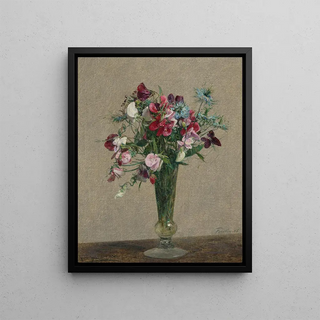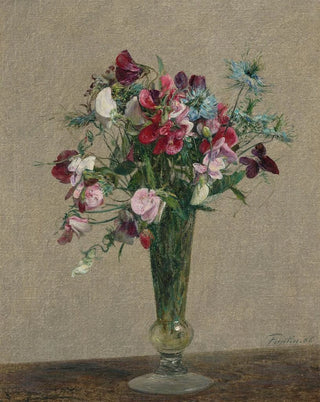Art print | Sweet Peas and Nigellas - Henri Fantin-Latour


View from behind

Frame (optional)
In the rich and delicate universe of floral painting, Henri Fantin-Latour's "Pois de senteur et nigelles" stands as a poignant testament to the ephemeral beauty of nature. This artwork, which captures the very essence of flowers, invites the viewer to a meditative contemplation, where each petal seems to vibrate with its own life. Through a subtle palette and delicate nuances, Fantin-Latour manages to transcend mere floral representation to offer an immersive aesthetic experience. The piece does not simply depict flowers; it evokes a sensory universe where fragrances and colors blend in perfect harmony, turning each glance into a sensory journey.
Style and uniqueness of the work
Fantin-Latour's technical mastery is evident in the precision of his brushstrokes and the delicacy of his approach. "Pois de senteur et nigelles" is distinguished by the richness of its textures and the finesse of its details, revealing meticulous attention to each element. The flowers, with their graceful forms, seem almost tangible, while the background, often blurred, creates a subtle contrast that highlights the beauty of the main subjects. Light plays a crucial role in this composition, illuminating the colors and emphasizing shadows, which gives the artwork depth and an almost three-dimensional quality. This ability to capture light and play with shadows is one of the characteristic traits of Fantin-Latour's style, who succeeds in infusing a soul into his creations.
The artist and his influence
Henri Fantin-Latour, born in 1836 in Grenoble, is an emblematic figure of the realist movement and a precursor of Impressionism. His career, marked by a passion for nature and floral representation, allowed him to establish himself as a master in the art of flower painting. Influenced by the great masters of the past, he developed a style that is uniquely his own, blending tradition and innovation. His works reflect an era where nature is celebrated and art becomes a means of expressing human emotions. Fantin-Latour also left a lasting imprint.

Matte finish

View from behind

Frame (optional)
In the rich and delicate universe of floral painting, Henri Fantin-Latour's "Pois de senteur et nigelles" stands as a poignant testament to the ephemeral beauty of nature. This artwork, which captures the very essence of flowers, invites the viewer to a meditative contemplation, where each petal seems to vibrate with its own life. Through a subtle palette and delicate nuances, Fantin-Latour manages to transcend mere floral representation to offer an immersive aesthetic experience. The piece does not simply depict flowers; it evokes a sensory universe where fragrances and colors blend in perfect harmony, turning each glance into a sensory journey.
Style and uniqueness of the work
Fantin-Latour's technical mastery is evident in the precision of his brushstrokes and the delicacy of his approach. "Pois de senteur et nigelles" is distinguished by the richness of its textures and the finesse of its details, revealing meticulous attention to each element. The flowers, with their graceful forms, seem almost tangible, while the background, often blurred, creates a subtle contrast that highlights the beauty of the main subjects. Light plays a crucial role in this composition, illuminating the colors and emphasizing shadows, which gives the artwork depth and an almost three-dimensional quality. This ability to capture light and play with shadows is one of the characteristic traits of Fantin-Latour's style, who succeeds in infusing a soul into his creations.
The artist and his influence
Henri Fantin-Latour, born in 1836 in Grenoble, is an emblematic figure of the realist movement and a precursor of Impressionism. His career, marked by a passion for nature and floral representation, allowed him to establish himself as a master in the art of flower painting. Influenced by the great masters of the past, he developed a style that is uniquely his own, blending tradition and innovation. His works reflect an era where nature is celebrated and art becomes a means of expressing human emotions. Fantin-Latour also left a lasting imprint.






